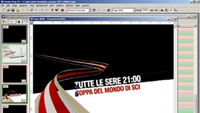ESPN Classic Sports automates promo creation

Many satellite channels in Europe face the same problem: how can they effectively brand and cross-promote their channels in many languages while avoiding excessive costs? Original programming is frequently available already subtitled or dubbed; however, promotional material has to be specially created for each channel.
ESPN Classic Sports faced just this problem. The broadcaster airs three direct-to-home services to France, Italy and the UK, plus a European service for cable operators. The channel playout services are provided by Red Bee Media.
ESPN use the Harris Vision for program scheduling. This creates program listings and the transmission schedule weeks ahead of transmission. This information can be used to build interstitial and in-program promotions. Many are self-promotional, and had been assembled in a four-machine linear edit suite. By their very nature, they are repetitive, especially the voice-overs, which consist of little more than viewing times.
ESPN Classic’s production team felt that automation could equal genuine cost savings. They wanted to automatically create versions of promotional end-boards with text and voice-overs in different languages. The goal was to have more people making promos, saving time in the edit suite.
The promo graphics conform to a limited set of templates, with the text added according to the Vision schedule. If the graphics could be built on the fly at the time of transmission, rather than in an editing session, then there would be a great expense cut. Another benefit of automation would be the flexibility for late schedule changes.
The master control system uses Pixel Power Clarity graphics systems driven by Omnibus automation. Pixel Power already had an application called Pixel Promo that was the right fit for the project, so ESPN’s team set out to design a system that would meet their exact requirements. In master control, the graphics are built with two Claritys. A 100 is used to overlay in-program promotions, and a downstream Clarity 200 to add promotional graphics, specifically the end-boards that display viewing times.
The Clarity 100 is synchronised to the primary video’s VITC and uses a process similar to subtitling to key the in-program promotions. The same keyer is also used to overlay in-program graphics over the sports events, giving ESPN branding in the three languages used for transmission.
The professional video industry's #1 source for news, trends and product and tech information. Sign up below.
The Clarity 200 is controlled by secondary events in the automation schedule. The Omnibus automation feeds the next 10 items to the Pixel Promo application. This is combined with the daily schedule and the EPG listing from Vision. From this information, the correct tags can be extracted to build the live end-board.
With such an automated system, there are always occasions when the information is missing; in this case, an email is dispatched to ESPN requesting the missing file. As a fallback, an end-board can be programmed with defaults like “coming soon.”
Five minutes before transmission, the template is loaded with the schedule appointment time plus program title extracted from the EPG listing and built on the fly. The appropriate audio clip plays in sync. ESPN recorded a total of 10,000 voice-over clips in three languages to cover all possible variations. This avoids the need for on going voice-over recording, also a money saver.
The system is now in use, and has freed valuable creative resources from the repetitive production of tape promos with attendant cost savings. It enables ESPN Classic Sports to create more informative promotional graphics for the viewers, and voice-overs in several languages, a very important aspect of brand promotion in the crowded space of satellite and cable delivery.
For more information, visit www.espnclassicsport.com and www.pixelpower.com.
